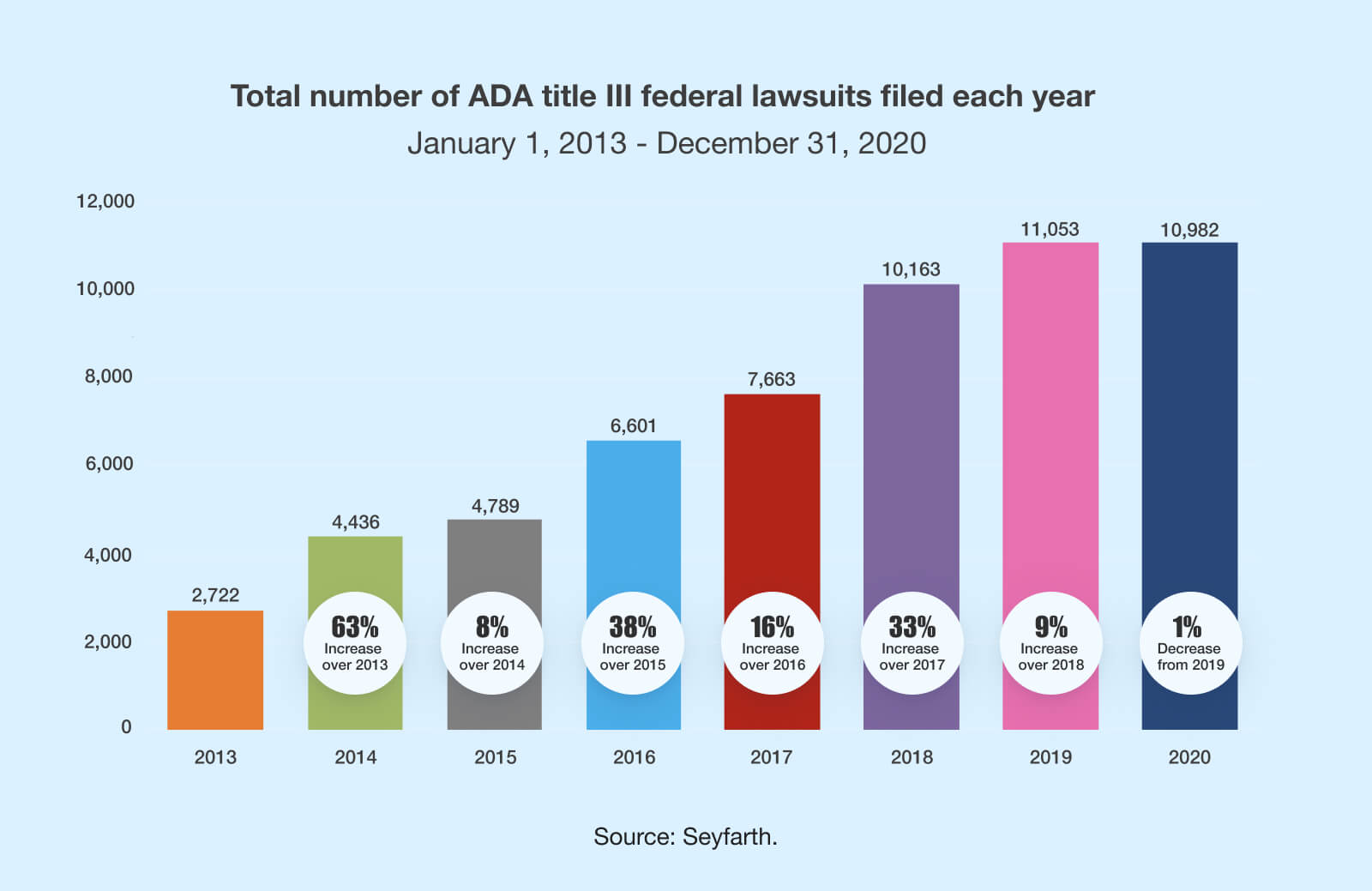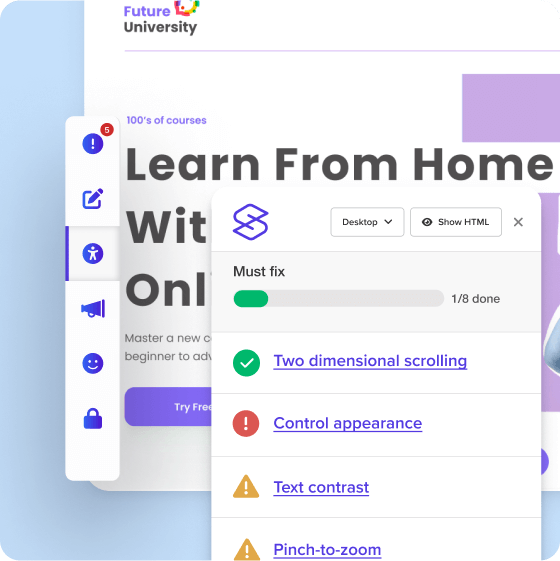What is the Americans with Disabilities Act (ADA)?
The ADA is a landmark civil rights law signed on July 26, 1990. Its core purpose is to prevent discrimination against individuals with disabilities in employment, public services, public accommodations, and telecommunications.
Although the original statute did not explicitly address digital content, evolving interpretations and court decisions have made it clear that websites and online services must also be accessible to individuals with disabilities.
The ADA is divided into several titles, each addressing different areas:
- Title I – Employment: Prohibits discrimination in hiring, promotions, and workplace accommodations for individuals with disabilities.
- Title II – Public services: Requires state and local governments to provide accessible programs, services, and transportation.
- Title III – Public accommodations and commercial facilities: Mandates that private businesses and nonprofit organizations open to the public provide equal access to goods and services. This title has been broadly interpreted to include websites and digital content.
- Title IV – Telecommunications: Ensures that telecommunications companies provide relay services for individuals with hearing or speech impairments.
- Title V – Miscellaneous provisions: Contains additional guidelines and protections related to the implementation of the Act.
For the latest official information on the ADA, visit ADA.gov.
Who does the ADA apply to?
The ADA applies to a wide range of entities:
- Employers: Private employers with 15 or more employees must ensure that qualified individuals with disabilities receive equal employment opportunities.
- State and local governments: Under Title II, public entities are required to provide accessible services and facilities.
- Public accommodations: Title III applies to businesses and nonprofit organizations that are open to the public—including retail stores, restaurants, hotels, theaters, and increasingly, digital platforms such as websites and mobile applications.
- Telecommunications providers: Under Title IV, companies must offer services that allow effective communication for individuals with disabilities.
These broad provisions mean that virtually any organization that interacts with the public may need to consider ADA compliance in both their physical spaces and digital environments.
The ADA and Digital Accessibility
Extending ADA protections to the web
Although the ADA was enacted before the internet became a central medium for information and commerce, subsequent court cases and DOJ guidance have extended its principles to the digital realm. Key points include:
- Interpretation by courts and DOJ: U.S. courts have increasingly ruled that websites are “places of public accommodation” under Title III, meaning they must be accessible to all users.
- Guiding standards: While the ADA does not specify a technical standard, the Web Content Accessibility Guidelines (WCAG)—especially WCAG 2.0 Level AA—are widely accepted as the benchmark for achieving digital accessibility.
- Enforcement uncertainty: The Department of Justice (DOJ) has not yet finalized formal web accessibility regulations. As a result, many ADA cases related to websites are settled out of court to avoid the expense and uncertainty of litigation.
Recent trends in ADA lawsuits
Recent years have seen a dramatic increase in ADA lawsuits focused on web accessibility:
- Increase in litigation: Lawsuits filed under Title III of the ADA have more than quadrupled over the past seven years. In sectors such as retail and restaurants, the number of cases has reached record levels, according to monitoring by legal groups like the Beckage Website Accessibility Team.
- Economic impact: With around 1.7 million active retail websites in the U.S., businesses with inaccessible digital platforms are facing significant legal and financial risks.
- Common claims: Typical allegations include improperly labeled links, inconsistent navigation, missing alternative text for images, and other code or design issues that hinder the use of screen readers and other assistive technologies.
If the rate at which web accessibility lawsuits have increased over recent years tells us anything, it’s that the threat of legal action is very real. In 2020, 10,982 ADA Title III lawsuits were filed in federal court, a number that was barely slowed by the COVID-19 pandemic.

These trends continue to accelerate drastically. In January 2021, 1,108 cases were filed – the most ever in a single month (source).
When it comes to US local government, the DOJ is very attentive, filing hundreds of lawsuits for allegedly violating the ADA. And with DOJ introducing new regulations, it’s a big sign that they plan on scaling up the velocity of lawsuits against local government organizations.
For more detailed insights on the rise of ADA lawsuits and practical strategies to avoid litigation, see Silktide’s articles such as Avoiding an ADA Lawsuit and Is Your Website Compliant with the ADA After the Latest DOJ Guidance?.
Enforcement of the ADA
Enforcement of the ADA is managed primarily by the Department of Justice (DOJ) along with private legal action initiated by affected individuals:
- DOJ investigations and settlements: The DOJ investigates complaints and can negotiate settlements with organizations that do not meet accessibility standards.
- Litigation: Individuals or advocacy groups can file lawsuits alleging violations of ADA requirements. Courts often reference WCAG guidelines as the industry standard for accessibility.
- Impact of settlements: Many cases are settled out of court to avoid protracted litigation, but the financial and reputational risks remain significant for non-compliant businesses.
What are the implications if my US websites are not accessible?
Nearly every well-known online retailer – including Target, Amazon, and Dominoes – has faced accessibility lawsuits. Target settled theirs for $6m. In many states, law firms are now actively searching for inaccessible websites to sue.
Data from our own Silktide Index highlights the top five accessibility issues facing government websites;
- Missing ‘Skip to content’ navigation
- Failure to identify form fields
- Using the same link text for different destinations
- Text with insufficient contrast
- Not marking navigation as lists
Any of these issues, while relatively simple to identify using Silktide’s platform, could leave you open to litigation.
How can I make my website ADA-compliant?
You may have an existing website or are building a brand-new one. Either way, the approach is very much the same. Watch our video to get a 4-step plan for starting your journey toward compliance.
How does Silktide help me comply with ADA?
Silktide’s platform automatically tests all your websites against the WCAG 2.2 (and WCAG 2.1/2.0) standards and presents you with remedial actions and educational information to help you become more accessible.
We’re able to automatically test all unambiguous success criteria, and we also cover the mobile device accessibility requirements introduced on the most recent WCAG 2.1 standards.
We would recommend that until such a time that the ADA defines the standards it uses, you ensure your website complies with WCAG 2.0 AA at an absolute minimum. You should additionally strive for mobile accessibility as per WCAG 2.1 AA.
While this article focuses on the ADA itself, it’s worth noting that Silktide’s web accessibility testing platform can be a valuable tool for ensuring your website meets or exceeds ADA standards:
- Automated web accessibility testing: Silktide continuously scans your website to identify issues in code, design, and content.
- Actionable reporting: It provides clear, step-by-step guidance on how to address identified problems.
- Ongoing monitoring and training: Silktide offers dashboards and reports to help your team track progress, as well as educational resources to promote long-term compliance.
Using a comprehensive tool like Silktide helps organizations not only reduce legal risks but also deliver a more inclusive experience for all users.
In summary
The Americans with Disabilities Act is a foundational law that has reshaped the landscape for accessibility in the United States. Although initially not crafted with the digital world in mind, the ADA’s principles now extend to websites and online services, mandating that businesses, public institutions, and government agencies provide accessible digital content. With a sharp increase in ADA-related lawsuits over recent years—particularly targeting sectors like retail and restaurants—the need for compliance has never been more critical.
Aligning your digital strategy with the widely accepted WCAG guidelines (currently WCAG 2.0 Level AA, with many opting for WCAG 2.1/2.2 for best practice) is essential to mitigate legal risk and serve a broader audience.
This article provides a detailed and accessible overview of the Americans with Disabilities Act as it pertains to website accessibility, including key historical details, scope, and enforcement trends. For tailored legal advice or compliance strategies, please consult an accessibility law expert.
Check your accessibility now with our free browser extension

